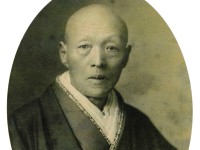Miyagawa (Makuzu) Kōzan (1842-1916)
Discover our beautiful collection of works by one of Japan's most influential artists.

Collection trails: 1 object
- Reference URL
Actions
Baluster vase with flowers
-
Description
This vase was made by the potter Miyagawa (Makuzu) Kōzan (1842-1916). Although Kōzan also produced ceramic works using earthenware and stoneware, this vase is an example of his works in porcelain, for which he is most famous. New underglaze colours, such as pink and green, that could withstand a high firing temperature, were developed around the time that this vase was made. Kōzan was one of the first to exploit the full range of these new possibilities for decoration.
-
Details
- Associated place
-
Asia › Japan › Honshū › Kantō › Kanagawa prefecture › Yokohama › Ota › Makuzu kiln-site (place of creation)
- Date
- 1900 - 1910
- Artist/maker
-
Miyagawa Kōzan (1842 - 1916) (potter)Makuzu kiln (1871 - 1959) (potter)
- Material and technique
- porcelain, decorated with white slip, and with polychrome underglaze enamels
- Dimensions
-
32 cm (height)
21.5 cm max. (diameter)
- Material index
- Technique index
- Object type index
-
container › vessel › vase › baluster vase
- No. of items
- 1
- Credit line
- Purchased with the assistance of the Story Fund, 1991.
- Accession no.
- EA1991.1
-
Further reading
Impey, Oliver, and Joyce Seaman, Japanese Decorative Arts of the Meiji Period 1868-1912, Ashmolean Handbooks (Oxford: Ashmolean Museum, 2005), no. 9 on p. 22, p. 8, illus. pp. 22-23
Impey, Oliver, ‘Reflections upon the Arts and Crafts of Meiji Period Japan with Reference to the Collection of the Ashmolean Museum’, Oriental Art, 42/3, (Autumn 1996), p. 12, illus. p. 13 fig. 6
Glossary (4)
earthenware, porcelain, slip, stoneware
-
earthenware
Ceramic material made of clay which is fired to a temperature of c.1000-1200⁰c. The resulting ceramic is non-vitreous and varies in colour from dark red to yellow.
-
porcelain
Ceramic material composed of kaolin, quartz, and feldspar which is fired to a temperature of c.1350-1400⁰c. The resulting ceramic is vitreous, translucent, and white in colour.
-
slip
A semi-fluid clay applied to a ceramic before glazing either to coat the surface or for decorative effect.
-
stoneware
Ceramic material made of clay which is fired to a temperature of c.1200-1300⁰c and is often buff or grey in colour.
Location
-
-
Second floor | Room 36 | Japan

-
Second floor | Room 36 | Japan
Objects are sometimes moved to a different location. Our object location data is usually updated on a monthly basis. Contact the Jameel Study Centre if you are planning to visit the museum to see a particular object on display, or would like to arrange an appointment to see an object in our reserve collections.
Collection trails
Publications online
-

Japanese Decorative Arts of the Meiji Period
Baluster-shaped porcelain vase decorated in underglaze green, white and mauve with raised white enamel, showing clumps of flowers on a mottled green ground. Signed on base in underglaze blue: Makuzu Kōzan sei.
New underglaze colours, such as pink and green, colours that would stand a high temperature firing, were developed around this time, partly through the assistance of Gottfried Wagener, a scientific polymath, who was an oyatoi gaijin, a foreigner employed by the Japanese government to develop Japanese industry and art industry. Kōzan was one of the first to seek his advice, and to exploit the full range of these colours (as was Namikawa Yasuyuki for enamels [see EA1988.1, EA1993.39, EA1995.151, EA2000.48, EA2000.180, EA2002.177]).
© 2013 University of Oxford - Ashmolean Museum










